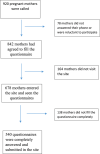Depression and anxiety among pregnant mothers in the initial stage of the Coronavirus Disease (COVID-19) pandemic in the southwest of Iran
- PMID: 34088329
- PMCID: PMC8177264
- DOI: 10.1186/s12978-021-01167-y
Depression and anxiety among pregnant mothers in the initial stage of the Coronavirus Disease (COVID-19) pandemic in the southwest of Iran
Abstract
BACKGROUND: Women are at a higher risk for depression progression, especially during pregnancy. The current study purposed to investigate depression, anxiety, and stress levels of pregnant mothers in the initial stage of the COVID-19 infection in the southwest of Iran.
Methods: This cross-sectional study was conducted during March and April, 2020, in Shiraz, Iran. Pregnant mothers registered in maternity clinics affiliated with Shiraz University of Medical Sciences were included. An online self-administered checklist was used. It included socio-demographic, obstetric and medical histories, and the short form of the Depression Anxiety Stress Scales (DASS-21) to evaluate depression, anxiety, and stress. A p-value < 0.05 was considered significant.
Results: In total, 540 pregnant mothers answered the questionnaire. 83.5% had no comorbidity. Abnormal depression scores were significantly higher in those who had no insurance (OR = 2.5) and in those with poor self-rated health (SRH) (OR = 27.8). Pregnant mothers with lower SRH and two or more comorbidities had a higher chance of having an abnormal level of anxiety subscale (6.9, 3.7 times, retrospectively).
Conclusion: The results revealed that an abnormal level of depression was associated with SRH and medical insurance status. Moreover, the number of comorbidities and poor SRH significantly increased the chance of achieving abnormal anxiety levels in pregnant mothers during the COVID-19 pandemic.
Keywords: Anxiety; COVID-19; DASS-21; Depression; Mental disorders; Pregnancy.
Plain language summary
Children of mothers who experience high psychological distress during pregnancy are more susceptible to cognitive and behavioral problems. Few studies have reported the psychological distress of pregnant mothers during the COVID-19 pandemic, and it may be considered as a risk factor for child developmental disorders.In total, 540 out of 920 registered pregnant mothers in maternity clinics affiliated with Shiraz University of Medical Sciences answered the online questionnaire and were included in this study. An online self-administered data gathering tool was used so that the respondents felt more secure. The data gathering tool had three main parts: socio-demographic, obstetric and medical histories, and the short form of the Depression Anxiety Stress Scales (DASS-21) which consisting of 21 questions, 7 in each subscale; depression (DASS-D), anxiety (DASS-A) and stress (DASS-S).Pregnant mothers who had two or more comorbidities or those with lower self-rated health (SRH) had a higher chance of having an abnormal anxiety level. Depression levels were higher in pregnant mothers who had no insurance. Additionally, depression symptoms were more prevalent in pregnant mothers who had low health status than in those with good or intermediated SRH.In conclusion, the COVID-19 pandemic contributes to a significant increase in depression and anxiety symptoms among pregnant mothers. Moreover, lack of insurance, poor SRH, and having comorbidities are significantly associated with increasing depressive and anxiety scores.
Conflict of interest statement
Nothing to be declared.
Similar articles
-
Uptrend in distress and psychiatric symptomatology in pregnant women during the coronavirus disease 2019 pandemic.Acta Obstet Gynecol Scand. 2020 Jul;99(7):848-855. doi: 10.1111/aogs.13925. Epub 2020 Jun 3. Acta Obstet Gynecol Scand. 2020. PMID: 32449178
-
Depression, stress, anxiety and their predictors in Iranian pregnant women during the outbreak of COVID-19.BMC Psychol. 2020 Sep 22;8(1):99. doi: 10.1186/s40359-020-00464-8. BMC Psychol. 2020. PMID: 32962764 Free PMC article.
-
The relationship between sexual function and mental health in Iranian pregnant women during the COVID-19 pandemic.BMC Pregnancy Childbirth. 2021 Apr 26;21(1):327. doi: 10.1186/s12884-021-03812-7. BMC Pregnancy Childbirth. 2021. PMID: 33902479 Free PMC article.
-
Prevalence of anxiety and depression among pregnant women during the COVID-19 pandemic: a meta-analysis.J Psychosom Obstet Gynaecol. 2022 Sep;43(3):315-326. doi: 10.1080/0167482X.2021.1929162. Epub 2021 Jun 24. J Psychosom Obstet Gynaecol. 2022. PMID: 34165032 Review.
-
Prevalence of anxiety, depression, and psychological distress among the general population during the COVID-19 pandemic: A systematic review and meta-analysis.Int J Soc Psychiatry. 2021 Nov;67(7):892-906. doi: 10.1177/00207640211003121. Epub 2021 Apr 1. Int J Soc Psychiatry. 2021. PMID: 33794717
Cited by
-
Mental Health of Iranian Pregnant Women During Pandemic of COVID-19: A Systematic Review.Iran J Nurs Midwifery Res. 2022 Nov 18;27(6):485-491. doi: 10.4103/ijnmr.ijnmr_205_22. eCollection 2022 Nov-Dec. Iran J Nurs Midwifery Res. 2022. PMID: 36712310 Free PMC article. Review.
-
COVID and depression among stratified population groups: a narrative review.Eur J Med Res. 2023 Aug 3;28(1):265. doi: 10.1186/s40001-023-01213-4. Eur J Med Res. 2023. PMID: 37537632 Free PMC article. Review.
-
Bushfires and Mothers' Mental Health in Pregnancy and Recent Post-Partum.Int J Environ Res Public Health. 2023 Dec 20;21(1):7. doi: 10.3390/ijerph21010007. Int J Environ Res Public Health. 2023. PMID: 38276795 Free PMC article.
-
The prevalence of mental ill-health in women during pregnancy and after childbirth during the Covid-19 pandemic: a systematic review and Meta-analysis.BMC Pregnancy Childbirth. 2023 Jan 28;23(1):76. doi: 10.1186/s12884-022-05243-4. BMC Pregnancy Childbirth. 2023. PMID: 36709255 Free PMC article.
-
Impacts of the COVID-19 Pandemic on Anxiety and Depressive Symptoms in Pregnant Women and Related Perinatal Outcomes.J Pers Med. 2022 Dec 30;13(1):94. doi: 10.3390/jpm13010094. J Pers Med. 2022. PMID: 36675755 Free PMC article.
References
-
- Organization WH: Coronavirus disease (COVID-2019) situation reports. https://www.who.int/emergencies/diseases/novel-coronavirus-2019/situatio... Accessed January 29 2021.
-
- Meattini I, Franco P, Belgioia L, Boldrini L, Botticella A, De Santis MC, et al. Radiation therapy during the coronavirus disease 2019 (covid-19) pandemic in Italy: a view of the nation’s young oncologists. BMJ Publishing Group Limited. 2020;5:e000779. doi: 10.1136/esmoopen-2020-000779. - DOI - PMC - PubMed
MeSH terms
LinkOut - more resources
Full Text Sources
Medical
Miscellaneous


